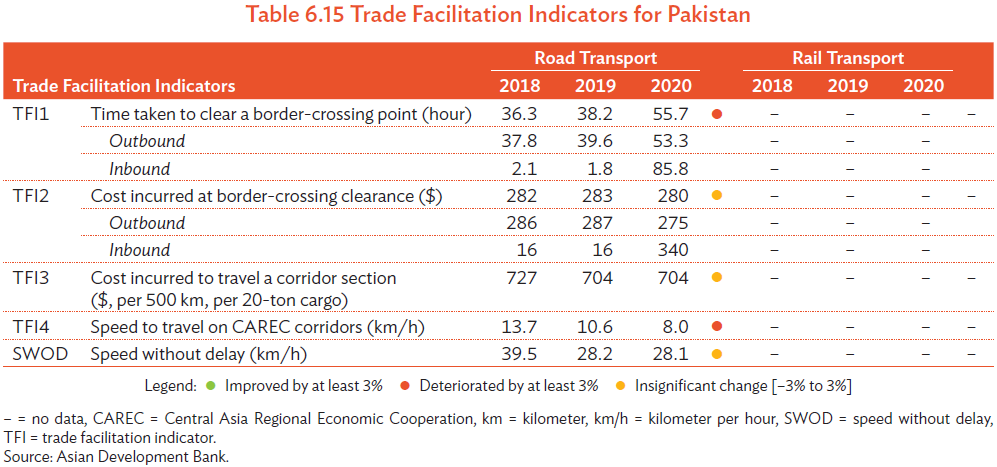The CPMM analysis relies on consistent and comparable data across CAREC countries, despite their inherent differences. This chapter provides an update of the main developments and CPMM data at a national level for each CAREC member country to help explain the trends or resulting outcomes at the regional or corridor level. This country-level analysis examines the policies, regulations, infrastructure, and institutional factors that can affect corridor performance. Pertinent barriers and issues are highlighted, key developments and progress are noted, and high-level recommendations are included.
The 2020 CPMM report introduces the four TFIs at the country level, segregated by road and rail transport, and further separated into outbound and inbound direction for border-crossing time and costs (Tables 6.1–6.22). These data are supplemented by average border-crossing time and cost for BCPs along relevant CAREC corridors. Key CPMM findings, updated trends and developments, and country-specific recommendations are also provided in this chapter.
Key Findings
- In 2020, the most significant impact of COVID-19 for road and rail transport was on border-crossing time. TFI1 averaged 55.7 hours, far above the 28.3 hours in 2019.
- Border-crossing fees and total transport costs were little changed. From 2019 to 2020, the former changed from $283 to $280, while the latter stayed at $704.
- SWOD changed from 10.6 km/h in 2019 to 8.0 km/h in 2020 and SWD changed from 28.2 km/h to 28.1 km/h.
- Torkham and Chaman continued to remain time-consuming BCPs, worsened by the pandemic. The average time to cross border at Torkham increased from 60.1 hours in 2019 to 70.7 hours in 2020, whereas Chaman increased from 35.7 hours in 2019 to 50.0 hours in 2020.


Trends and Developments
Pakistan continued intensive efforts to increase transit and trade efficiency, adopting modern trade facilitation measures. Work on national single window and authorized economic operators continued. The customs management system called WeBoc31 was upgraded to perform multimodal transit to effect TIR operations.32 The National Logistics Policy was sent to the Federal Cabinet for review at the beginning of 2021.
When COVID-19 began to raise alarms worldwide, the government ordered a moratorium on all cross-border activities beginning early March 2020, resulting in stoppage of all border activities at Torkham and Chaman BCPs. This resulted in a large number of containers bound for Afghanistan being stuck at the seaport, inland customs offices, and at the two BCPs. By 14 March 2020, Pakistan Customs reported that 1,587 containers and 526 containers remained in Quetta and Peshawar, respectively, after they were released from Karachi seaport. In the meantime, the containers’ seals were intact and stayed in the customs bonded zone. By 22 April 2020, it was estimated that in Karachi at least 6,000 TEUs got stranded in the seaport bound for Afghanistan.
The strict measures to contain the outbreak led to economic hardships, which resulted in the government reviewing and adopting some countermeasures. The Ministry of Interior ordered partial reopening in April and resumed 6 days operations in May 2020 for Torkham and Chaman. The Directorate General of Transit Trade agreed to the waive demurrage and detention charges on containers held up in Pakistan to provide temporary relief for the shippers and transport operators.
The impact of the stricter measures to counteract COVID-19 led to severe lengthening of border-crossing time. The average border-crossing time in Q2 2020 for Pakistan surged to 81 hours on average, which was double that of Q2 2019 and Q1 2020. This was driven by the increased border-crossing time at both Torkham and Chaman in Q2 2020. Throughout 2020, the border-crossings remained challenging due to the additional sanitary controls and health checks, on top of the existing time-consuming procedures.
Recommendations
- Approve the National Freight Logistics Policy. The National Freight Logistics Policy (NFLP) consists of 10 objectives, 13 policy actions, and 125 specific recommendations. The endorsement of the policy by the Cabinet will resolve many long-standing issues that constrain the freight and logistics sector, such as port congestion, underdeveloped multimodal transport, and high cost of transportation. Yet as of Q1 2021, the Cabinet has not formally endorsed the policy since it was completed in March 2020.
- Enhance traffic control via “smart parks and tags.” Pakistan authorities have taken action to terminate illegal private parking lots near the border and implemented radio frequency identification (RFID)-enabled tags to coordinate movements of vehicles, so that border-crossing at major BCPs such as Torkham could be more efficient. Nevertheless, strong actions are needed as the shortage of tags during COVID-19 resulted in additional delays. Private operators of parking space could be encouraged under public–private partnership so that the vehicles do indeed move in a coordinated and organized manner, using smart technologies such as RFID. (References could be made to Georgia’s Sarpi BCP at the Turkish border described in CPMM Annual Report 2017).
- Promote Ghulam Khan as an international border-crossing point. Torkham is consistently one of the most time-consuming BCP due to high traffic, and presently the situation is aggravated by the ongoing construction works under CAREC Regional Improvement of Border Services (RIBS) project. Pakistan has already designated Ghulam Khan as the third international BCP, a laudable move that needs to be supported with infrastructure upgrades and installment of equipment and trained personnel. This would attract traffic and relieve the congestion at Torkham.
- Incentivize freight trains from Karachi to Peshawar. Currently, all Afghan transit trade are transported on trucks. New freight train services were launched in 2019, from Karachi to Lahore. If the freight train service could extend to Peshawar as the terminus, this would allow a cost-effective solution to facilitate transit trade and reduce shipment costs, which are now high due to the sole reliance on trucking.
